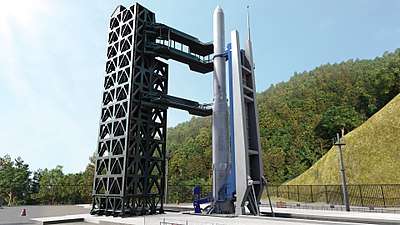KSLV-II
 CGI render of a KSLV-II at the launch pad | |
| Country of origin | South Korea |
|---|---|
| Size | |
| Height | 47.2 m (155 ft)[1] |
| Diameter | 3.5 m (11 ft)[1] |
| Mass | 200,000 kg (440,000 lb)[1] |
| Stages | 3[1] |
| Capacity | |
| Payload to LEO | 1,500 kg (3,300 lb) |
| Boosters | |
| Thrust | 75,000 kgf (740,000 N; 170,000 lbf) |
KSLV-II, also known as Nuli (누리), is South Korea's second carrier rocket and the successor of KSLV-1.[2] This three-stage rocket is entirely developed by the Korea Aerospace Research Institute (KARI), and planned launched into space in 2021.[3] All stages will use indigenously developed rocket engines. The South Korean government is setting SpaceX as a role model, especially in making cheaper and reliable rockets for commercial launch service. The goal is to launch a 1,500 kg payload into a 600–800 km low Earth orbit (LEO)[3] and 2,600 kg into a 300 km LEO.[4]
Specification
KSLV-II is a three-stage rocket. First stage booster uses four 75 ton force engines, generating nearly 300t of thrust with specific impulse of 298.1. Second stage booster uses one 75 ton force engine, which uses a wider nozzle for efficiency in vacuum with specific impulse of 315.4. Third stage booster uses one 7 ton force engine with specific impulse of 325.1s. All engines use rocket-grade kerosene (RP-1) as its fuel and liquid oxygen (LOX) as its oxidizer. Further improvements will be added after the success of KSLV-II program, such as replacing the current engine configurations with 85 or 95 ton force and increasing specific impulse. The first stage engine is designed to be reused, just like the Merlin 1D engine. This engine can be reused after being recovered, which lowers costs and improves efficiency of the launch program.
Usage
KSLV-II will be used in launching several Earth observing satellites, such as KOMPSAT, medium-class satellites and LEO reconnaissance satellites. KSLV-II is planned to be used in South Korea's moon exploration mission to send orbiters and landers to the moon. KSLV-II will be South Korea's first rocket to enter the launch vehicle service market. KSLV-II's launch cost will be approximately $30 million, offering cheap launch service for South-East Asian countries.
See also
- KSLV-I
- Naro Space Center
- Falcon 9 (uses engine clustering, similar to KSLV-II)
References
- 1 2 3 4 "Korea Space Launch Vehicle KSLV-Ⅱ". Korea Aerospace Research Institute.
- ↑ "[출처: 중앙일보] 설계부터 제작까지 100% 국산 로켓 내달 발사". JoongAng Ilbo. September 7, 2018.
- 1 2 "Korea Space Launch Vehicle KSLV-II". Korea Aerospace Research Institute. Retrieved 7 December 2016.
- ↑ "네이버 뉴스".